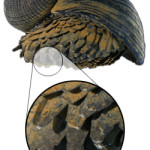
The Johnson-Sea-Link manned submersible (Photo courtesy of Chip Baumberger)
Nature provides a treasure-trove of chemicals that can be used in chemical manufacturing processes, or developed into drugs for the treatment of human disease. Since the discovery of penicillin in 1929 and its impact on the treatment of infections, the pharmaceutical industry has used terrestrial microorganisms as a productive source of new therapeutic agents. In fact, the majority of antibiotics currently used in clinical practice are derived from microbial products. The intensity of this research led to a dramatic reduction in the rate of discovery of novel compounds.
New environmental niches provide a new source of microbes and potential for novel compound production. Tthe microbial community of marine invertebrates is one such niche. Over the last 20 years at Harbor Branch Oceanographic Institution we have developed a culture collection containing 17,000 bacteria and fungi from deep-water marine invertebrates and sediments. We have shown that the collection contains many unusual microbes which are not known from the terrestrial environment and we are fermenting the isolates to produce extracts for screening as antibacterial or anticancer agents.
Our antibacterial screening is focused on the discovery of agents effective against the so-called “superbugs”, pathogens such as MRSA that are resistant to most commonly prescribed antibacterial agents. By looking for the secondary metabolites in deep-sea niches, we expect to find compounds that differ from those of the terrestrial environment. These compounds will provide clinically-relevant antibiotics to meet current challenges.
During a recent expedition to the Florida Keys, scientists from the Marine Natural Products Discovery Group at Harbor Branch Oceanographic Institution conducted a mission to cultivate bacteria and fungi from deep water sponges, soft corals and sediments. We used the Johnson-Sea-Link manned submersible to dive as deep as 1000m and then, thanks to the skill of the sub pilots, collect samples of invertebrates and sediments using the robotic tools mounted on the front of the submersible.
After the sub returned to the deck of the RV Seward Johnson, the samples are sorted and a small sub-sample is removed for microbiological evaluation. The sample is ground in sterile seawater, diluted, and inoculated into a series of solid and liquid growth media. Plates are typically incubated for 3-6 months before we isolate individual microbes and work out what we found.
Why do we have such a great interest in deep-water microbes? The answer is two-fold: firstly we are interested in understanding the types of microbes present in these niche environments and how they interact since the microbial population of sponges may be up to 60% of the invertebrate’s mass; secondly, there is a tremendous potential for these microbes to produce valuable chemicals.

A marine bacterium showing storage of large quantities of lipids
In addition to finding new therapeutic agents we are also exploring the potential of these microbes to produce industrial chemicals and enzymes. Betty Dietsch, a summer intern funded through the Gertrude E. Skelly Charitable Foundation, spent 10 weeks studying the production and storage of lipids in bacteria from the culture collection. Further research will determine the potential of these chemicals as industrial components or nutritional supplements.

Kathleen Janda and Tara Pitts sample specimens for microbial isolation
(Photo courtesy of Chip Baumberger)
Peter McCarthy is at the Center for Ocean Exploration, Harbor Branch Oceanographic Institute at Florida Atlantic University
Further Reading:
Sfanos, K.A., C.L. Peterson, D.K. Harmody, P.J. McCarthy, S.A. Pomponi and J.V. Lopez. A molecular systematic survey of sponge-derived marine microbes. Systematic Appl. Microbiol. 28:242-264 (2005).
Olson J.B., and P.J. McCarthy. Associated bacterial communities of two deep-water sponges. Aquatic Microb. Ecol. 30:47-55 (2005).
Olson, J.B., D.K. Harmody, A. Bej, and P.J. McCarthy. Tsukamurella spongiae sp. nov., a novel actinomycete isolated from a deep-water marine sponge. Int. J. Syst. Evol. Microbiol. 57(7):1478-1481 (2007).
Bruck, T.B., W.M. Bruck, L.Z. Santiago-Vazquez, P.J. McCarthy and R.G. Kerr. Diversity of the bacterial communities associated with the azooanthellate deep water octocorals Leptogorgia minimata, Icillogorgia scrammii, and Swiftia exertia. Marine Biotechnol. In Press (2007).
Cassler, M., C.L. Peterson, A. Ledger, S.A. Pomponi, A.E. Wright, R. Winegar, P.J. McCarthy, and J.V. Lopez. Use of Real-Time qPCR to quantify members of the unculturable heterotrophic bacterial community in a deep sea marine sponge, Vetulina sp. Microbial Ecology. In Press (2007).




